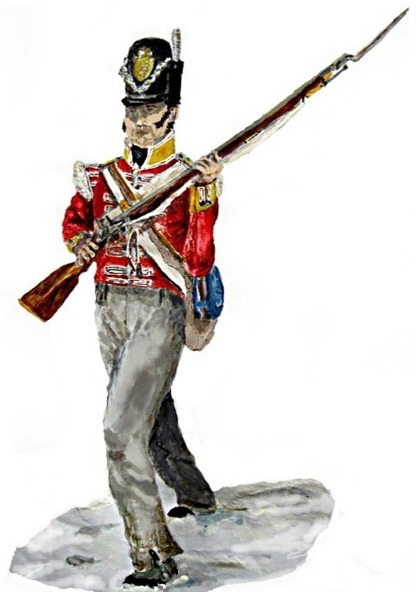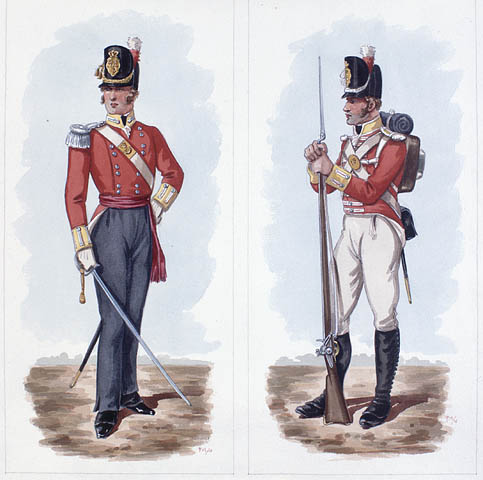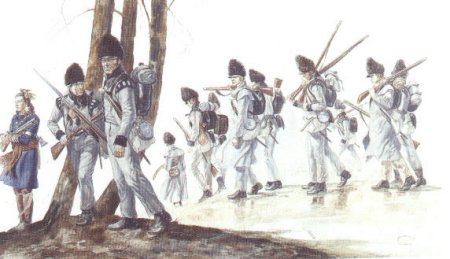
13th Regiment of Foot
Grenadier. He carries his
musket at the "Port Arms"; the position used in a bayonet charge.
(Watercolour Sketch by Robert Henderson)
The following article
is a synopsis of the battle. The author is presently
writing a small book on this almost forgotten clash of arms.
Considering the dramatic bravery exhibited on both sides of the
battlefield, it is somewhat surprising this event has been lost in
the sands of time. After military setbacks the previous Autumn
and a winter of extreme privation, the American soldier had emerged
from the ashes as a professional warrior. Lacolle is an
important link in this painful evolution. Wilkinson's plan was
the flaw, not the U.S. soldier.
After his defeat at
Cryslerís Farm by a vastly inferior in number enemy and a poorly handled
retreat from French Mills on the St. Lawrence river in February, Major
General James Wilkinson in March 1814 was again planning an invasion of
Canada. The dishonoured general hoped that a quick victory against a small
British force, would help him avoid condemnation by his superiors in
Washington for his previous campaign.
Leaving
Plattsburg, NY and moving up along Lake Champlain, Wilkinsonís army of four
thousand men crossed the Canadian frontier on March 30th and to attack a
small outpost at Lacolle Mills. After taking the wrong road, the US riflemen
leading the advance fell in with the Canadian Voltiguers supported by
the Grenadier company of the Canadian Regiment. Realizing their
mistake the US army countermarched and put itself upon the correct road to
Lacolle. It was during these initial encounters that the Congreve
rocket was first used on a North American land battle.
With the main road blocked by abattis, a running fire fight ensued with
the Canadian Frontier Light Infantry and Mohawk warriors through the
woods along a sleigh path that emerged at the US army's target.
Housed in a stone mill and a
wooden blockhouse were a company of 13th Regiment of Foot numbering 70
to 80 men and a detachment of Royal Marines. These troops were
reinforced by the 13th Regimentís Grenadier and Light companies from
Isle aux Noix, a distance of seven miles. Meanwhile Wilkinsonís
force quickly established a battery of a 12 pounder iron gun and, for a
brief period of time, a 5 Ĺ inch howitzer, in hopes of dislodging
the members of the 13th barricaded in the stone mill. A rapid thaw
of that day had made roads horrible resulting in damage to the 18
pounder cannon which kept it out of the action.

13th Regiment Battalion
Company Officer and Private (should also have Grey Trousers) LAC
Assessing the
battery to be the chief threat to his position at Lacolle Mills, the British
commander Major Handcock ordered the 13th flank companies to attack the
guns. After a spirited charge lead by the Grenaders, Handcock withdrew with
a number of casualties. The small garrison maintained a brisk fire upon the
US Light Artillery and Infantry positions resulting in considerable
casualties amongst the cannon crew. At one point both the officer
commanding the US Artillery and his successor fell wounded. Hearing the
noise of Wilkinsonís investment of Lacolle, the Canadian Voltiguers and
Canadian Grenadiers on the other road, two miles distant, moved to reinforce
Handcock. With the spring thaw, these were forced to wade at time up to
their waists in icy water as they made their way to the action. Making their
way through a hole in the US lines, Captain Cartwright of the Canadian
Fencibles, in charge of the small Canadian force, ordered an immediate
attack on the guns. The heavy US infantry support of the battery checked
this new attempt and regained the artillery that momentarily fell into enemy
hands.

Canadian
Voltigeurs on the march to reinforce Lacolle Mills
(painting by G.A. Embleton, copyright Parks Canada)
The battery in the end proved ineffective in
breaching the walls of the mill. After hours of little success and with
Lacolle reinforced to over 500 men and supported by Royal Navy gunboats,
Wilkinson decide to withdrew. When the US Army left the battlefield,
the expectation was they would return the following day to complete their
work. Mother Nature however intervened with torrential rain that
night and the following day, effectively ending the enterprise.
The
losses to the Americans were 13 killed, 128 wounded and 13 missing. The
British casualties were lighter with 11 killed, 46 wounded, and 4
missing; the majority of which coming from the 13th Grenadier and Light
Company attack on the guns.
British
Report on the Engagement
The following is a letter written by the lieutenant colonel of the 13th
Regiment to Major General Vincent, in command of the region south of
Montreal providing further details of the battle including the active
participation of the Royal Navy and Marines in the engagement:
ďLa Cole, March 31st, 1814
Sir,
I beg leave to acquiant you that
I have just received from Major Handcock of the 13th Regiment Commanding
at the Block house on La Cole rvier, a report stating that the out Post
on the roads from Burtonville, and La Cole Mill leading to oDell Town
were attacked at an early hour yesterday morning by the Enemy in great
force collected from Platsburg, and Burlington under the Command of
Major General Wilkinson. The attack on the Burtonville road was soon
over, when the Enemy shewed themselves on the road from the Mill that
leads direct to oDellTown where they drove in a picket stationed in
advance of La Cole about a mile & half distantand soon after the Enemy
established a Battery of three Guns (12 pounders) in the Wood.--with
this Artillery they began to fire on the Mill.--when Major Handcock
hearing of the arrival of the Flank Comapnies of the 13th Regiment at
the Block house he ordered an attack on the Guns which however was not
successful from the wood being so thick and so filed with men; soon
after another opportunity presented itself when the Canadian Grenadier
Company and a Company of the Voltigeurs attempted the Guns but the very
great superiority of the Enemyís numbers hid in the woods prevented
their taking them-- I have to regret the loss of many brave & good
Soldiers in these two attacks, and am particularly sorry to lose the
services for a short time of Captain Ellard of the 13th Regiment from
being wounded, while gallantly leading his Company.
The Enemy withdrew their
Artillery towards night fall, and retired towards morning from the Mill
taking th road to Odell Town.
Major Handcock speaks in high
terms of obligation to Captain Ritter of the Frontier Light Infantry who
from his knowledge of the country was of great benefit. The Marine
detachment under Lieuts. Caldwell & Barton, The Canadian Grenadier
Company, and the Company of Voltiguers, as well as all the troops
employed the Major expresses himself in high terms of praise for their
conduct so honorable to the Service--
Major Handcock feels exceedingly
indebted to Captain Pring Royal Navy for his ready & prompt assistance
in moving up the Sloop and Gun boats from Isle aux Noix to the entrance
of the La Cole river, the fire from which was so distructive. Lieut.
Creswick & Lieut. Hicks of the R.N. were most zealous in forwarding the
Stores, and landing two Guns from the Boats and getting them up to the
Mill.
To Major Handcock the greatest
praise is due for his most gallant defence of the Mill against such
superior numbers, and I earnestly trust it will meet the approbation of
His Excellency, The Comr. of the Forces. I have the honor to transmit a
list of the Killed & wounded of the British that of the Enemy from all
accounts I can collect from the Inhabitants must have been far greater.
I have the honor to be Sir
Your most obedient Humble Servant,
William Williams
Lieut. Col. 13th Regt
Comg. At Saint Johns"
[Library and Archives of Canada, Record
Group 8, Series I, vol. 682, p.289]
Copyright
Access Heritage Inc (formerly The Discriminating General) 1998

Copyright:
Unless otherwise noted, all information, images, data contained within
this website is protected by copyright under international law.
Any unauthorized use of material contained here is strictly forbidden.
All rights reserved.
.

